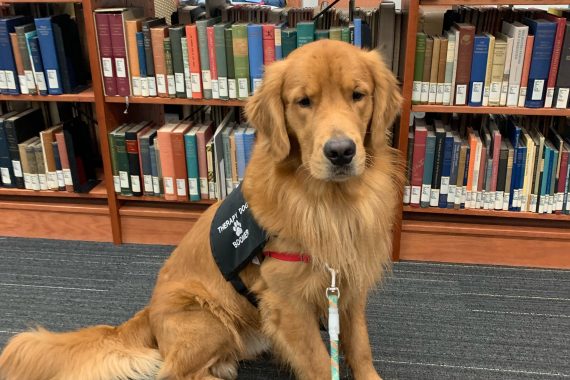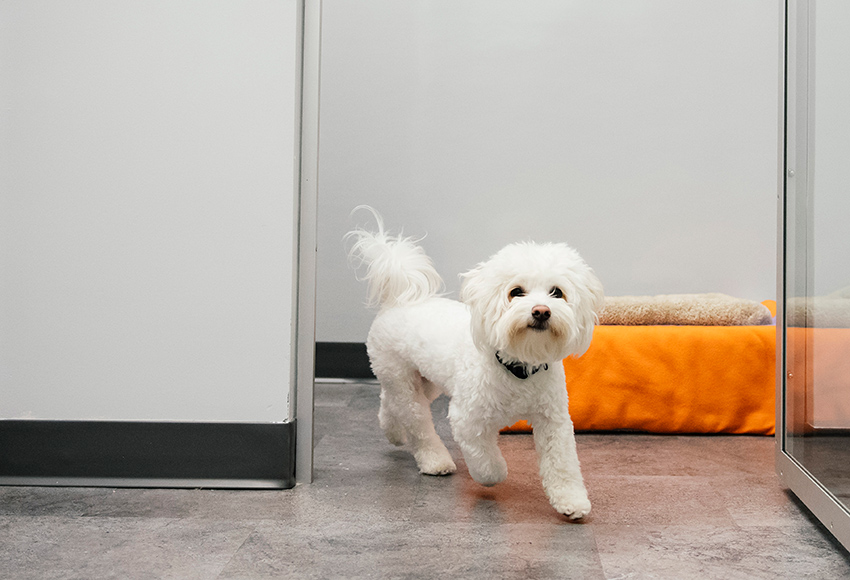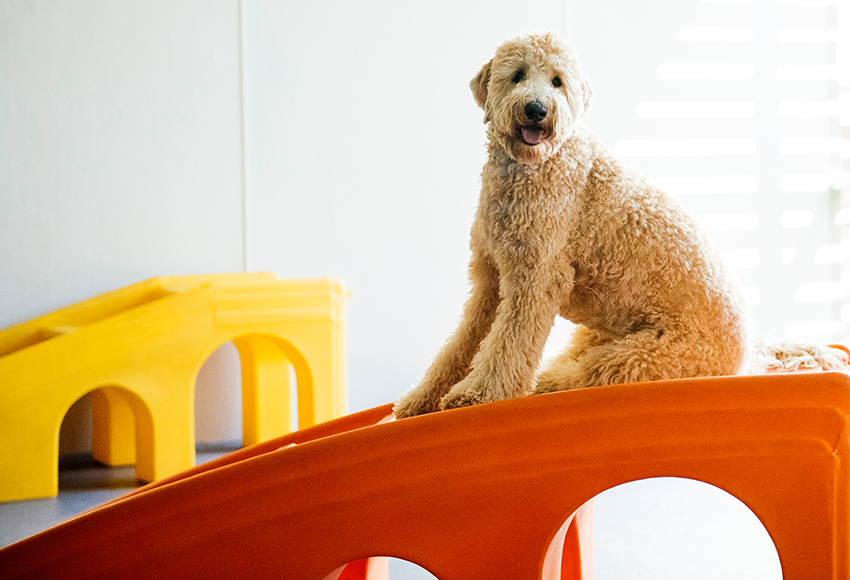Becoming a Pet Therapy Team
January 18, 2021

Pet therapy can be an incredibly rewarding volunteer experience. It’s a path that I chose to take back in 2019 and it has been an amazing journey. Our golden retriever, Boomer, and I were certified in November of 2019, and we have been volunteering in various environments since that time.
Pet therapy is very different than a dog being a service animal. A service dog is trained to focus and help one individual. Because of the focus on that person, it is always important you don’t interact with the pup unless given permission to do so. Pet therapy is designed for the pup to actively engage people. You and your pup are a trained team, engaging people to touch and pet your dog.
As a team, Boomer and I have visited high schools, hospitals, universities and local businesses. Being able to walk into an environment not accustomed to seeing dogs in the building, and then see the reaction of people as they interact with your dog is priceless. What I have also discovered is the incredible comfort and joy Boomer brings to patients at hospitals and people in hospice at home – it is those moments that make all the work we put into becoming a team worthwhile.
When customers and friends hear that we are a certified pet therapy team, the most popular questions we get is how did you do it and how long does it take?
Steps to becoming a certified pet therapy team
One of the first things to do is identify whether you believe your pup has the right mindset and demeanor for pet therapy. It is not a path for every dog. You are likely not an expert in pet therapy, but there are signals to indicate if your dog might be fit for this line of work. Answering questions such as:
- Are they comfortable around strangers?
- Are they confident and easy to manage when they go to public places such as coffee shops, Home Depot, Lowes, Academy?
- Do they enjoy others petting them and touching them?
I have found over time that these questions are a great starting point to begin to identify if a dog will enjoy pet therapy work.
If you think your dog is fit for the work, the next step is to find an organization that will offer training and certification. Boomer and I worked with the Dog Alliance here in the Austin, TX area. Every city has multiple groups that can offer the training and certification.
The organization can also help give you a sense for whether or dog will do well with this type of work. During the classes and practice sessions, you will also quickly learn if you and your dog is ready to take on this responsibility.
Why is pet therapy certification important?
Gaining the certification acknowledgement checks several boxes for you. First, it provides insurance coverage for you, your pet, and the people you engage with when you are representing the organization on pet therapy engagements. Second, the organization will likely provide insight to their certified teams on what local companies, schools, hospitals, would like to have pet therapy visits.
Also keep in mind that certification is between you and your dog. No one else is certified with the pup unless they also go through the class work and testing. A spouse cannot take your pup and represent the organization. That responsibility lies with only you and your dog.
How long does pet therapy certification take?
The answer to this question is going to vary depending on the age of the pet, their experience, and most importantly – YOU. It took us 9 months to become certified. We did the process in 3 steps. First, we took a puppy training class because at the time we started, Boomer was only 9 months old. Often with pet therapy organizations, they require a pup to be at least one year of age to be certified. I decided to start us early on classes and get accustomed to the work. Our second step was to gain certification through a Canine Good Citizen (CGC) class. We took this class because I knew it was a great preparation for the pet therapy testing – many of the skills learned in a CGC class show up in pet therapy certification. Our last step was taking the pet therapy class.
The pet therapy class was six weeks in length. We would meet once a week with the class and instructor to learn about a new element of pet therapy and some of the tests. In the class, we would practice the various tests, and get feedback on areas to work on. During the week between classes, Boomer and I were constantly practicing. We’d practice in the front yard, at local outdoor shopping areas, in home improvement stores and anywhere else I could find new encounters, sounds, shopping carts, etc, to get Boomer acclimated to new environments.
Pet Therapy Testing and Environments
Once you complete the pet therapy class, you are now ready for the test. The test is focused on both you and your pup, proving you can work as team. You can be certified for either Simple or Complex environments. Simple environments are typically 1×1 encounters like nursing homes. Complex environments are a higher level and involve working at locations where more random situations can occur, such as hospitals, businesses and universities.
Many teams start on the Simple level and then move on to the Complex. Boomer and I were lucky to test our way right into the Complex environments. I’ll chalk that up to a combination of a lot of practice and the amazing personality and confidence of Boomer.
The Pet Therapy Reward is Incredible
After completing all the classwork and testing, going out into the “real” world as a pet therapy team is a fun experience. We have a lot of fun visiting locations throughout the Austin area. He has become a bit of a celebrity in the Austin area. He gets requests from the hospitals to come out and visit the staff and patients, he’s made special home visits for folks in hospice, and people have recognized him walking around from his visits to the University of Texas and local high schools. But in the end, he is still our family dog, and loves to jump on you in the morning to wake you up, go for walks in the park and fetching the ball. We just get to share him with a bigger family!







